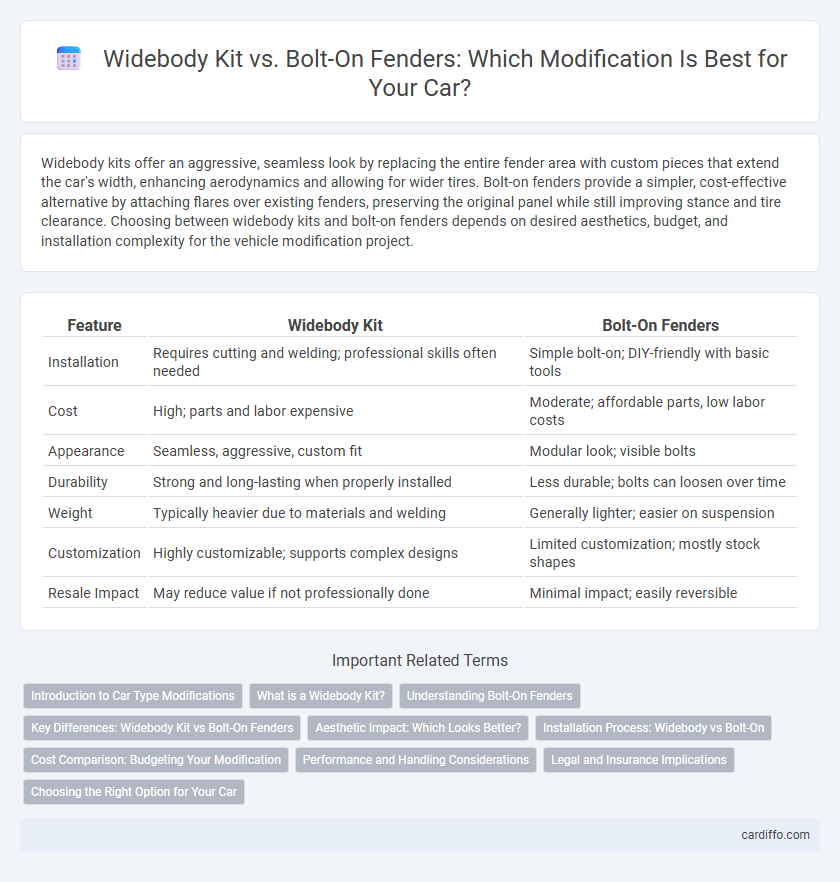Widebody kits offer an aggressive, seamless look by replacing the entire fender area with custom pieces that extend the car's width, enhancing aerodynamics and allowing for wider tires. Bolt-on fenders provide a simpler, cost-effective alternative by attaching flares over existing fenders, preserving the original panel while still improving stance and tire clearance. Choosing between widebody kits and bolt-on fenders depends on desired aesthetics, budget, and installation complexity for the vehicle modification project.
Table of Comparison
| Feature | Widebody Kit | Bolt-On Fenders |
|---|---|---|
| Installation | Requires cutting and welding; professional skills often needed | Simple bolt-on; DIY-friendly with basic tools |
| Cost | High; parts and labor expensive | Moderate; affordable parts, low labor costs |
| Appearance | Seamless, aggressive, custom fit | Modular look; visible bolts |
| Durability | Strong and long-lasting when properly installed | Less durable; bolts can loosen over time |
| Weight | Typically heavier due to materials and welding | Generally lighter; easier on suspension |
| Customization | Highly customizable; supports complex designs | Limited customization; mostly stock shapes |
| Resale Impact | May reduce value if not professionally done | Minimal impact; easily reversible |
Introduction to Car Type Modifications
Widebody kits significantly alter a vehicle's appearance and aerodynamics by extending the fenders and allowing for wider tires, enhancing both aesthetics and performance. Bolt-on fenders offer a less invasive modification, providing subtle changes with easier installation and removal, ideal for preserving the car's original structure. Both options cater to different modification goals, balancing visual impact, functionality, and customization preferences in car type modifications.
What is a Widebody Kit?
A widebody kit is a comprehensive modification consisting of extended fenders and body panels designed to increase a vehicle's width for improved aerodynamics and aggressive aesthetics. Unlike bolt-on fenders, which are individual components attached to existing bodywork, widebody kits often require cutting and reshaping the original panels to seamlessly integrate the wider stance. These kits enhance handling by accommodating wider tires and typically include custom bumpers, side skirts, and flares for a cohesive, high-performance appearance.
Understanding Bolt-On Fenders
Bolt-on fenders offer a practical modification option for enhancing vehicle width without the extensive body work required by widebody kits, providing simpler installation and reversibility. These fenders bolt directly onto existing body panels, preserving the car's structural integrity while achieving a more aggressive stance and improved tire clearance. Their lightweight design often results in better performance and ease of maintenance compared to the heavier, more complex widebody kits.
Key Differences: Widebody Kit vs Bolt-On Fenders
Widebody kits involve extending the vehicle's fenders by adding molded panels that blend seamlessly with the car's body, offering a more integrated and aerodynamic appearance. Bolt-on fenders are separate components attached using visible fasteners, allowing easier installation and removal but often resulting in a less smooth fit. Widebody kits typically require more extensive modification and fabrication compared to the simpler, more cost-effective bolt-on fender approach.
Aesthetic Impact: Which Looks Better?
Widebody kits create a more aggressive and muscular aesthetic by significantly expanding the vehicle's stance and emphasizing wider wheels and tires, resulting in a dramatic visual transformation. Bolt-on fenders offer a subtler enhancement by adding a sleek, tapered look without altering the car's overall silhouette as drastically. Enthusiasts seeking a bold and striking presence typically prefer widebody kits, while those aiming for a refined yet sporty appearance often choose bolt-on fenders.
Installation Process: Widebody vs Bolt-On
Widebody kits require extensive cutting, welding, and precise alignment, demanding advanced skills and more time during installation, whereas bolt-on fenders offer a straightforward process involving pre-drilled holes and simple hardware attachment. Widebody kits often necessitate professional tools and bodywork expertise to ensure seamless integration with the vehicle's structure, while bolt-on fenders can typically be installed by enthusiasts with basic mechanical knowledge. The complexity of widebody kits results in higher labor costs and longer installation times compared to the relatively quick and less invasive bolt-on fender setup.
Cost Comparison: Budgeting Your Modification
Widebody kits typically carry a higher cost due to extensive materials and labor, often ranging from $2,000 to $10,000, including paint and installation. Bolt-on fenders are a more budget-friendly alternative, averaging between $500 and $2,500, with simpler installation and fewer modifications required. Budgeting for widebody kits demands consideration of structural reinforcements and professional fitting, while bolt-on fenders allow for quicker, cost-effective customization.
Performance and Handling Considerations
Widebody kits enhance performance by allowing wider tires, which improve grip and cornering stability, crucial for high-speed handling. Bolt-on fenders offer a lightweight alternative, reducing added weight and preserving suspension dynamics for responsive steering. Both modifications impact aerodynamics differently, with widebody kits often providing more downforce, while bolt-on fenders focus on minimal drag increase.
Legal and Insurance Implications
Widebody kits often require extensive modifications that may need certification to comply with vehicle safety and emissions regulations, potentially affecting legal roadworthiness. Bolt-on fenders typically involve less structural alteration, making them easier to insure and less likely to impact a vehicle's warranty or insurance premiums. Insurance providers may increase rates or deny coverage if widebody modifications are undocumented or deemed unsafe, emphasizing the importance of proper documentation and compliance for both modification types.
Choosing the Right Option for Your Car
Widebody kits offer a more aggressive and seamless appearance by extending the car's fenders with custom fiberglass or carbon fiber panels, ideal for enhanced aerodynamics and wider tires. Bolt-on fenders provide a simpler and more cost-effective solution, attaching directly to the existing bodywork without extensive modification, making them perfect for those seeking quick installation and easy reversibility. Selecting between these options depends on your budget, desired aesthetic, and whether permanent structural changes are acceptable for your car.
widebody kit vs bolt-on fenders Infographic

 cardiffo.com
cardiffo.com